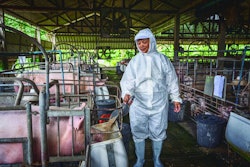
Corn variety from Penn State reduce incidence of necrotic enteritis by nearly half
The humblest of feed ingredients — corn — could be engineered to help fight necrotic enteritis in the future, reducing the need for antibiotics in poultry production, according to new research from The Pennsylvania State University.
In a recent feeding trial, published this month in the journal Poultry Science, birds fed a specialty variety of corn developed by Penn State plant geneticist were 48% less likely to develop intestinal lesions from necrotic enteritis. The chicks also gained weight faster, had a better feed conversion ratio and had a 23% lower mortality rate than those fed a control diet containing conventional corn, according to the study.
Necrotic enteritis “is a very aggressive disease, and very important in antibiotic-free flocks, which are about half of national production, so that’s give or take 4 million broilers per year produced in this country, and several of those four million chickens will struggle with necrotic enteritis,” said Gino Lorenzoni, an assistant professor of animal science and an extension veterinarian at Penn State. “This is very important for potential use in the industry.”
The corn in the study was bred specifically to contain high levels of compounds called flavonoids, which previous research suggested could protect against necrotic enteritis. While the exact reason why flavonoids prevent disease is unknown, the compounds could play an antioxidant or anti-inflammatory role, preventing damage in the intestine, Lorenzoni said.
Flavonoids can be found in other potential ingredients, Lorenzoni said, but it’s difficult to incorporate a high enough dose of flavonoids into poultry diets without causing unwanted side effects. For example, grape pomace — what’s left of the fruit after the juice is extracted — contains large amounts of flavonoids. But it’s also high in tannins, which at high levels can reduce feed performance, Lorenzoni said.
Corn, on the other hand, can comprise 60% to 65% of the bird’s diet without negative effects. And flavonoids occur naturally in corn at lower doses, Lorenzoni said. All that’s needed is a little hybridization to increase flavonoid production.
Some barriers to the use of the high-flavonoid corn variety still exist, Lorenzoni said. The new corn variety isn’t capable of achieving the yields necessary to achieve commercial viability, so more work will need to take place to improve the variety before it can be made available outside research institutions — a process that is likely to take at least a couple of years, Lorenzoni said. But the results of the recent trial shed light on a potential approach to reducing dependence on antibiotics that would require minimal changes to the diet.
“It’s very promising, so we’re going to continue working to develop more insight,” Lorenzoni said. “We need more information, more time to understand what are the possibilities of working with this corn in poultry.”















